September 11th, 2025
11 Domo Alternatives in 2025: Pros, Cons, and Pricing
By Simon Avila · 35 min read
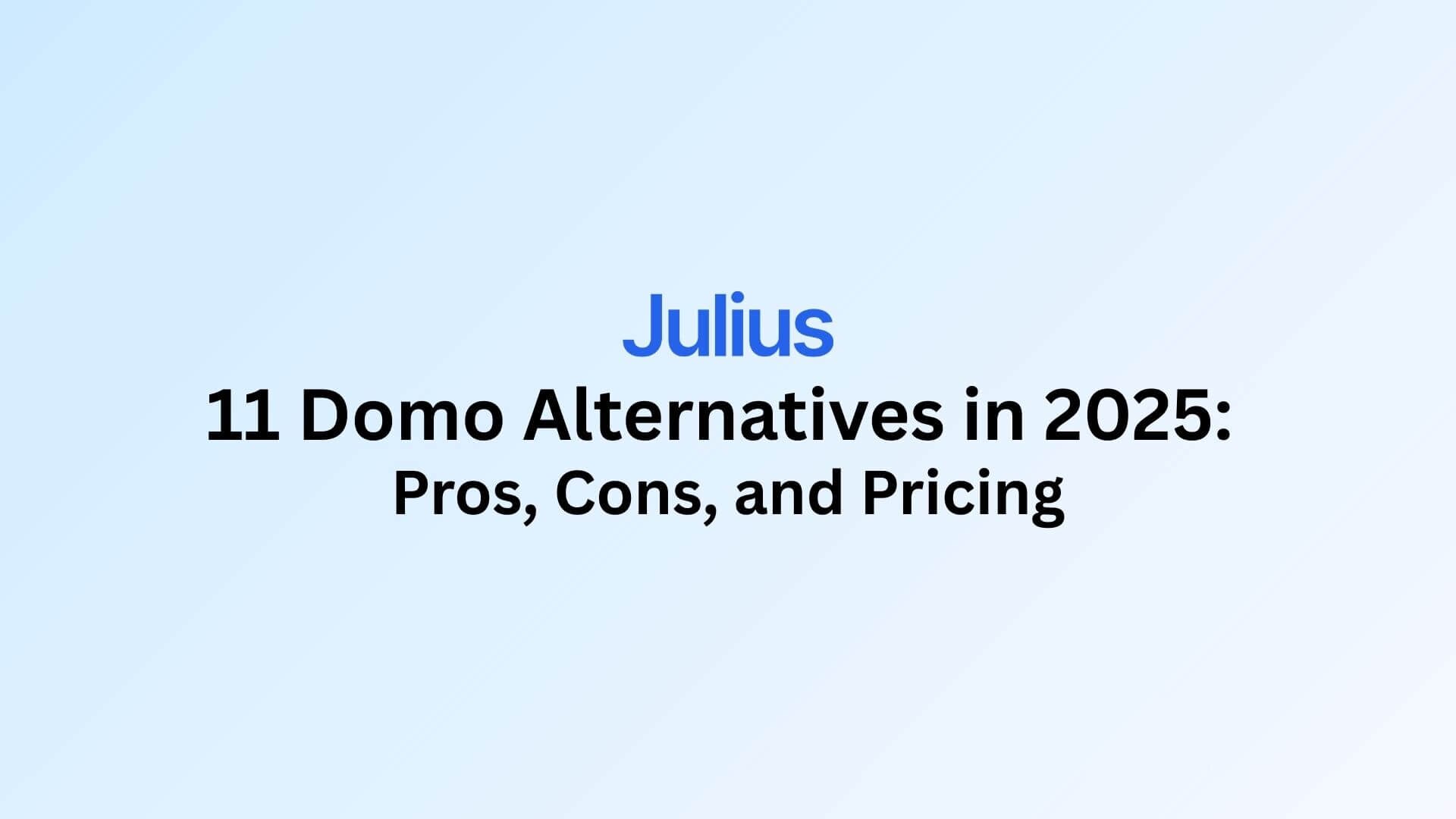
Domo’s annual contracts start at five figures, which puts it out of reach for many small and mid-sized teams. That’s why I tested 11 Domo alternatives in 2025 to see which ones give you clear reporting and insights without the enterprise-level price tag.
Expert take:
My strongest results came from matching my needs with the right tool. Julius was the easiest tool to use. I could type a question in plain English and see a chart in seconds, without touching SQL or building dashboards. Tableau excelled at deep visualizations, and Power BI stood out as the most budget-friendly option.
11 Best Domo alternatives in 2025: TL;DR
Each tool I tried shines in different areas, whether it’s visualization, search-driven analytics, or embedded dashboards. Here’s the quick breakdown:
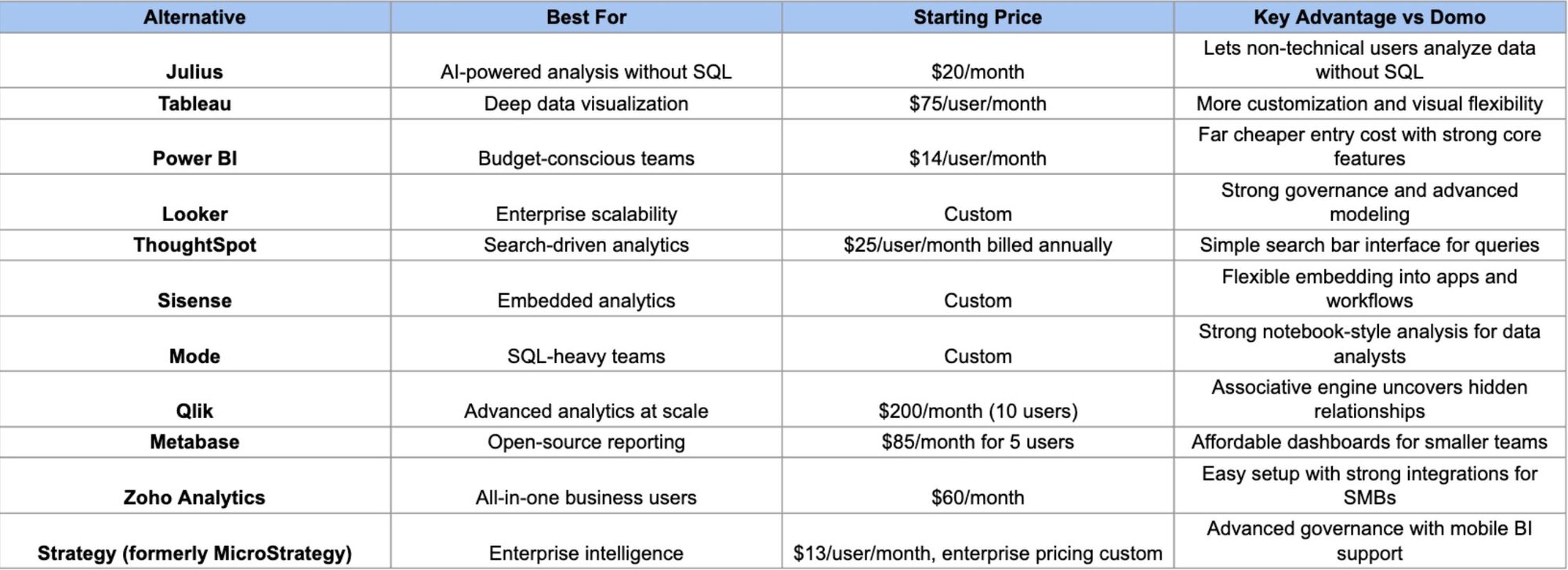
Why I looked for Domo alternatives
Domo can handle big data projects, but the pricing and complexity don’t work for everyone. I’ve seen sales reps quote minimum annual contracts in the five-figure range, and smaller teams often say that’s more than they can afford. I ran into the same wall years ago when I was managing marketing dashboards for my team and wanted to try Domo.
Even when cost isn’t the barrier, the setup can feel heavy. Many non-SQL users mention they rely on features like connectors and Beast Modes, but those still take time to master.
From what I’ve tested and read, it seems three pain points drive most teams to explore alternatives to Domo:
Pricing pressure: Entry costs can climb into enterprise territory even if you don’t need enterprise-scale features.
Steep learning curve: Without SQL skills, it takes effort to unlock Domo’s full power.
Flexibility limits: Custom dashboards and smaller-scale use cases aren’t always a smooth fit.
1. Julius: Best for AI-powered analysis without SQL
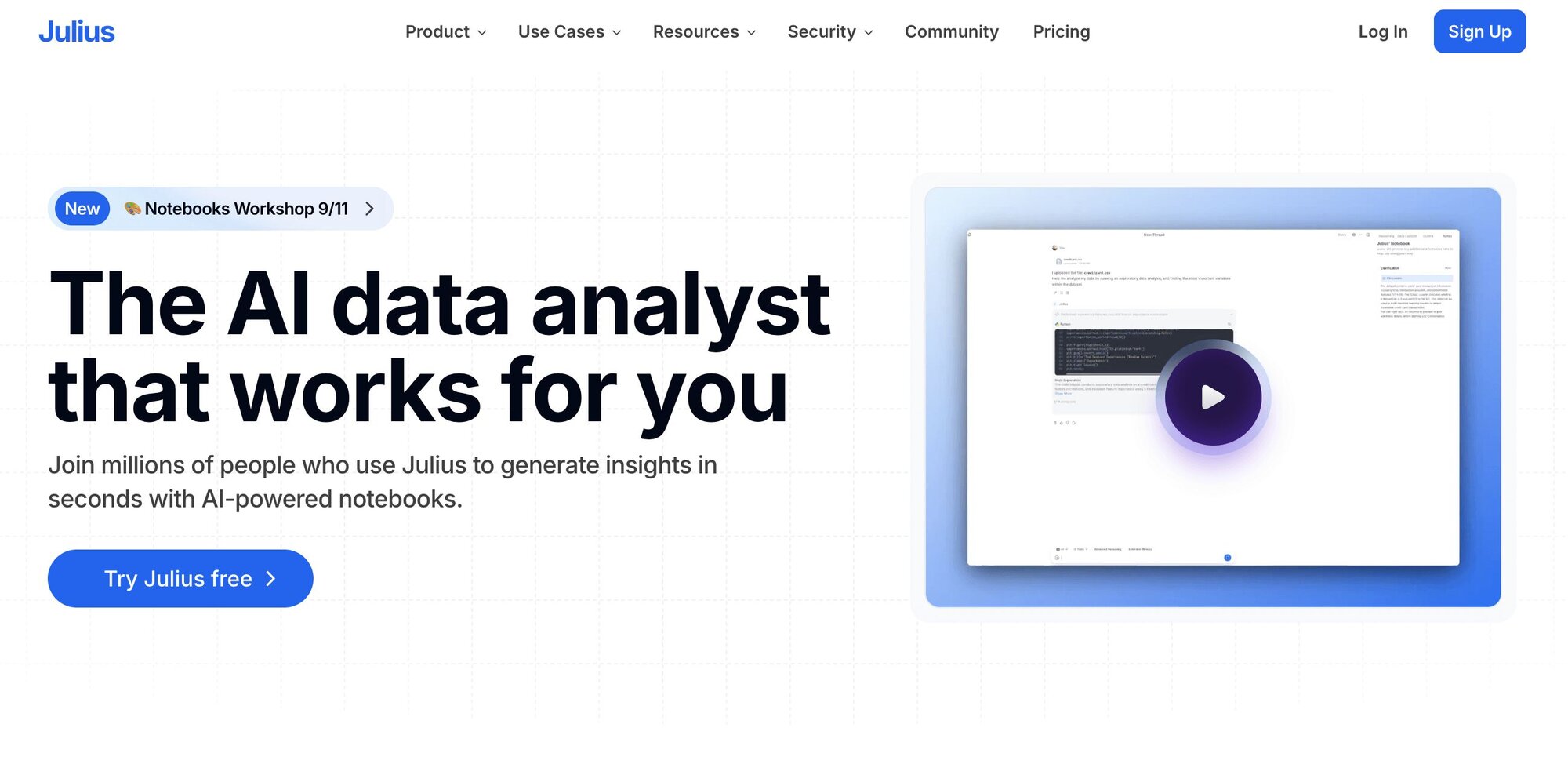
We designed Julius to speed up the finance and operations tasks (or any tasks really) that usually drag. It lets us ask plain-language questions and get answers right away, whether that’s a quick cash flow check or net revenue retention across cohorts. That flexibility sets it apart from FP&A systems that need more upfront setup.
We also built strong database connectors for Postgres, Snowflake, BigQuery, Google Ads, MCP, and more, so you can bring data in without touching SQL. You can schedule recurring reports to hit Slack or email automatically, which keeps your team updated without extra work.
Notebooks let you save analyses like NRR or cash flow and rerun them with new data whenever you need. We lean on these features ourselves when pulling metrics for weekly reviews and board meetings.
Where Julius really differs from traditional BI tools is how fast you can get from question to insight. Domo often requires dashboard builds, data modeling, and time from analysts before you see value. Julius strips that away.
In Julius, you can upload a CSV, connect a warehouse, or even link a marketing account like Google Ads and start asking questions in the same session. For non-technical teams, that speed means fewer bottlenecks.
That said, Julius isn’t meant to replace everything. It won’t serve as your system of record for accounting like NetSuite, or give you enterprise-scale forecasting like Workday Adaptive. Where it shines is in the daily and weekly rhythm of analysis, like quick checks, recurring reports, and clear charts you can use in meetings without fuss.
Why it beats Domo
Lower entry cost: Start with a free plan or affordable monthly pricing instead of five-figure contracts.
Easier to use: Ask plain-language questions and see results without touching SQL.
Quicker setup: Connect a database or upload a file and get insights in the same session.
Pros
Direct connectors for Postgres, Snowflake, Google Ads, MCPs, and more.
Scheduled reports keep weekly updates on track.
Notebooks make it easy to package analysis for board meetings.
Cons
Not a replacement for full FP&A platforms when you need structured forecasting or multi-entity consolidations.
Still a younger platform compared to legacy BI tools, so it has a smaller third-party ecosystem.
Pricing
You can try Julius on the free forever plan. Plans start at $20 per month for 250 messages to Julius.
Bottom line
We run our own reports in Julius because it saves time on routine checks and makes meetings clearer. It won’t replace full FP&A systems, but for fast analysis and reliable updates, it’s the tool we keep coming back to.
2. Tableau: Best for deep data visualization
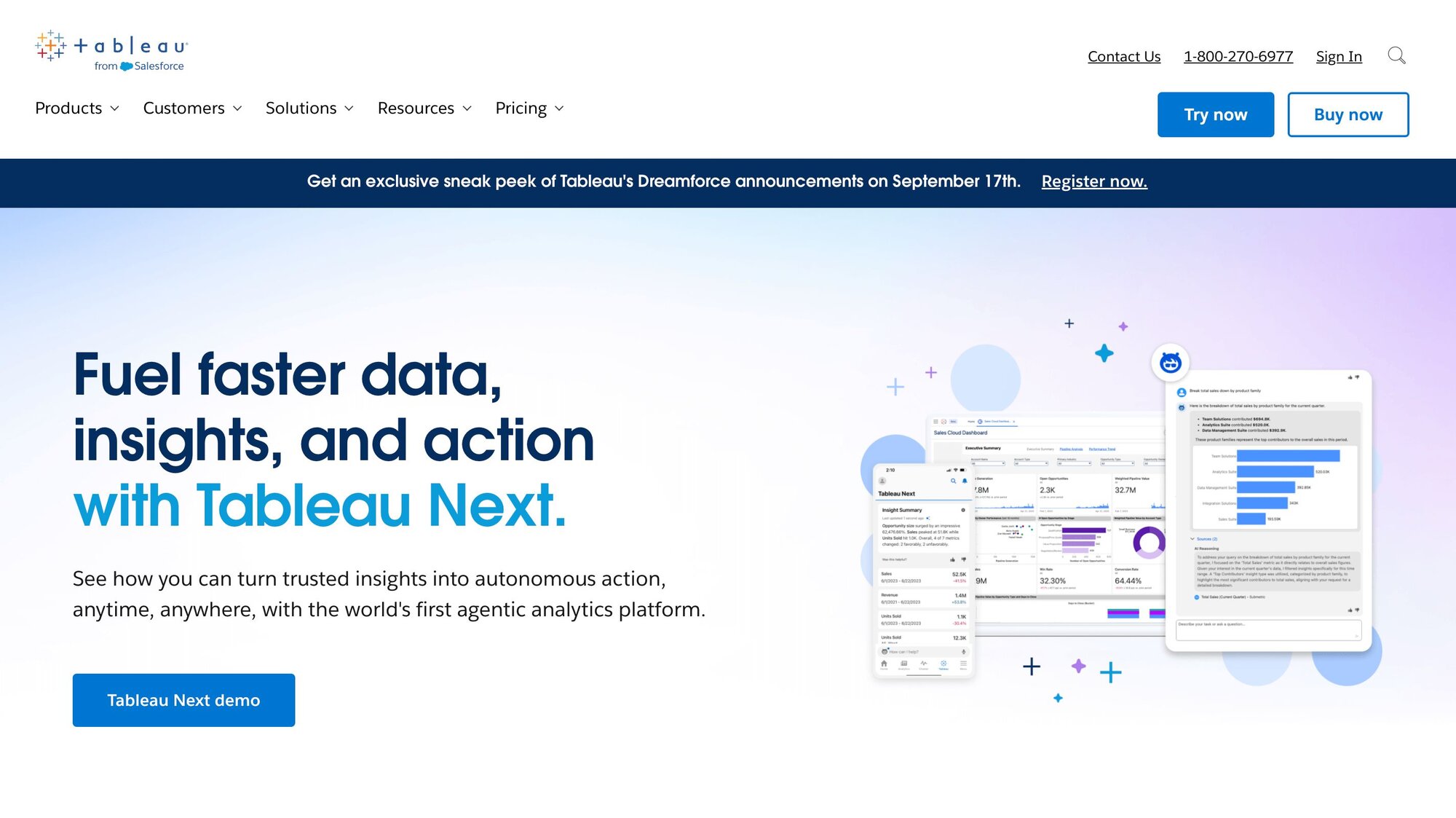
When I tested Tableau, I spent the most time experimenting with its graph maker features. Building dashboards was flexible. I could drag in data, switch chart types on the fly, and fine-tune layouts until they looked board-ready.
For example, I built a sales pipeline dashboard where I could drill into regions and product lines without leaving the main view. That kind of customization made it feel stronger than what I could do in Domo.
Tableau also handled larger datasets better in my tests, especially when pulling from Snowflake and BigQuery.
The flip side is the learning curve. I had to spend time watching tutorials and practicing before the interface felt natural. Once I got through that, though, I was able to produce dashboards that looked more polished than anything I could make in Domo.
Why it beats Domo
Tailored dashboards: Build views that fit your exact KPIs and let you drill down into the details that matter.
Presentation-ready visuals: Share dashboards with leadership without needing extra design work.
Learning resources everywhere: Tap into a large community for tutorials, templates, and troubleshooting.
Pros
Wide range of chart types and visual controls.
Strong integrations with databases and cloud warehouses.
Active community for problem-solving.
Cons
Steep learning curve for new users.
Licensing can get expensive as teams grow.
Pricing
There are three options for pricing: Tableau, Enterprise, and Tableau+. Pricing for the Tableau Creator tier is $75 per user per month (billed annually).
Bottom line
Tableau is a good option if visuals are a priority. It takes more training than some tools, but once you learn the interface, the dashboards look more polished than what I built in Domo.
3. Power BI: Best for budget-conscious teams
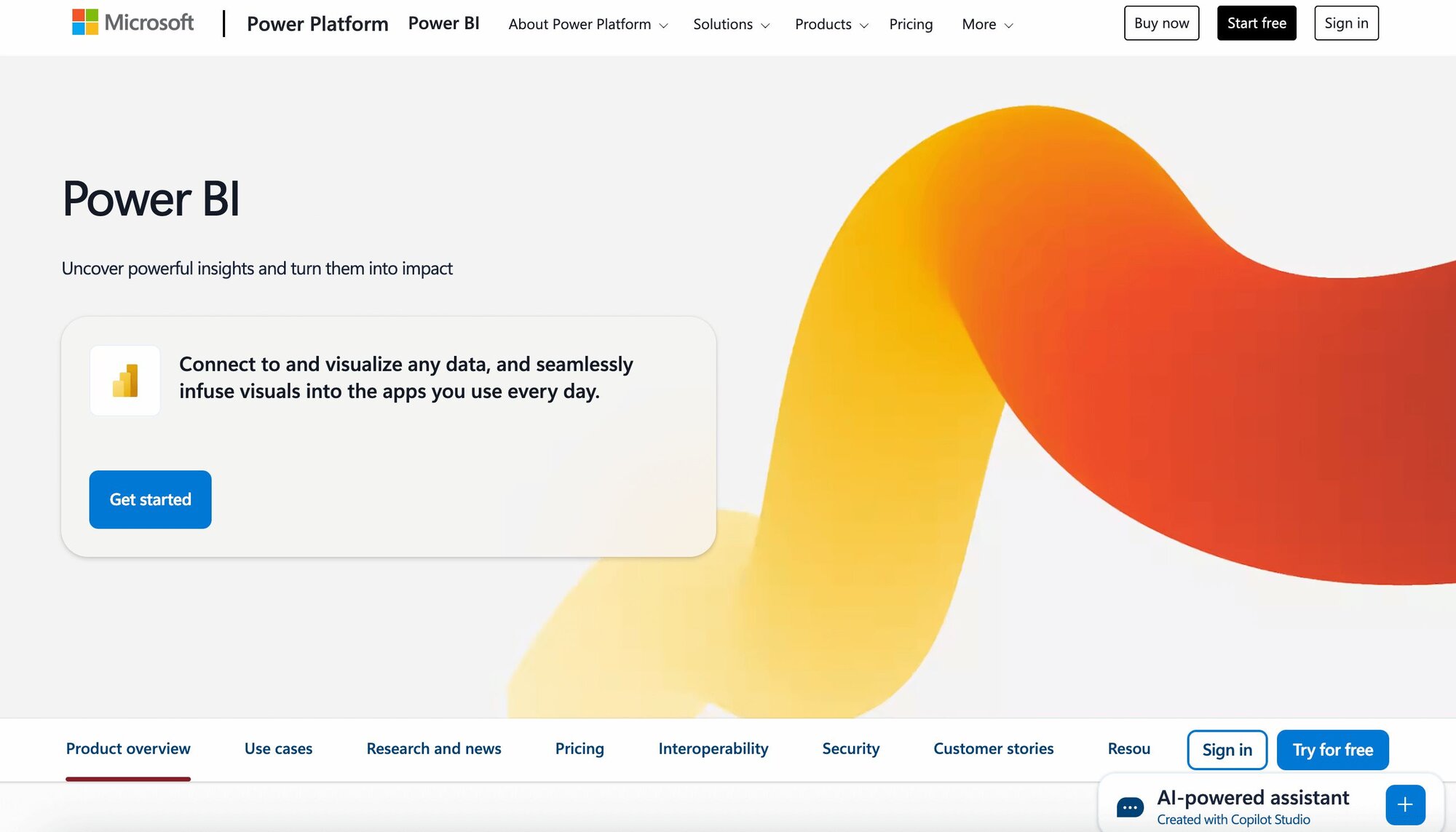
The first thing I noticed about Power BI was the price. At around $14 per user per month, it sits far below Domo’s five-figure contracts and still covers the core jobs most teams need.
When I tried it, I connected Excel sheets and SQL databases in minutes, and the interface looked familiar since it followed Microsoft’s design style. That familiarity made it easier to start exploring, especially if you’ve spent time in Excel.
When I tested it with larger datasets, though, Power BI slowed down. Loading millions of rows from a warehouse felt clunky, and I had to adjust my queries to make it run smoothly. It also took effort to unlock the more advanced features. For example, I had to learn how to build relationships between tables and tweak measures before the dashboards matched what I wanted.
Why it beats Domo
Lower cost: Keep expenses predictable with per-user pricing instead of five-figure contracts.
Excel-friendly setup: Import spreadsheets and reuse formulas your team already knows.
Familiar design: Work in an interface that feels similar to other Microsoft apps, which shortens the learning curve.
Pros
Very low entry cost.
Strong integration with Excel and the Microsoft ecosystem.
Wide range of learning resources available.
Cons
Can slow down with large datasets.
Requires setup work to unlock advanced features.
Pricing
Power BI has a free plan. Paid plans start at $14 per user per month, paid annually. It’s also included in Microsoft 365 E5 and Office 365 E5 if you are already subscribed to those services.
Bottom line
Power BI is a practical choice if you need analytics on a tighter budget. Power BI alternatives like Tableau or Qlik offer more advanced visuals, but the low monthly cost makes Power BI hard to ignore if saving money is your main priority.4. Looker: Best for enterprise scalability
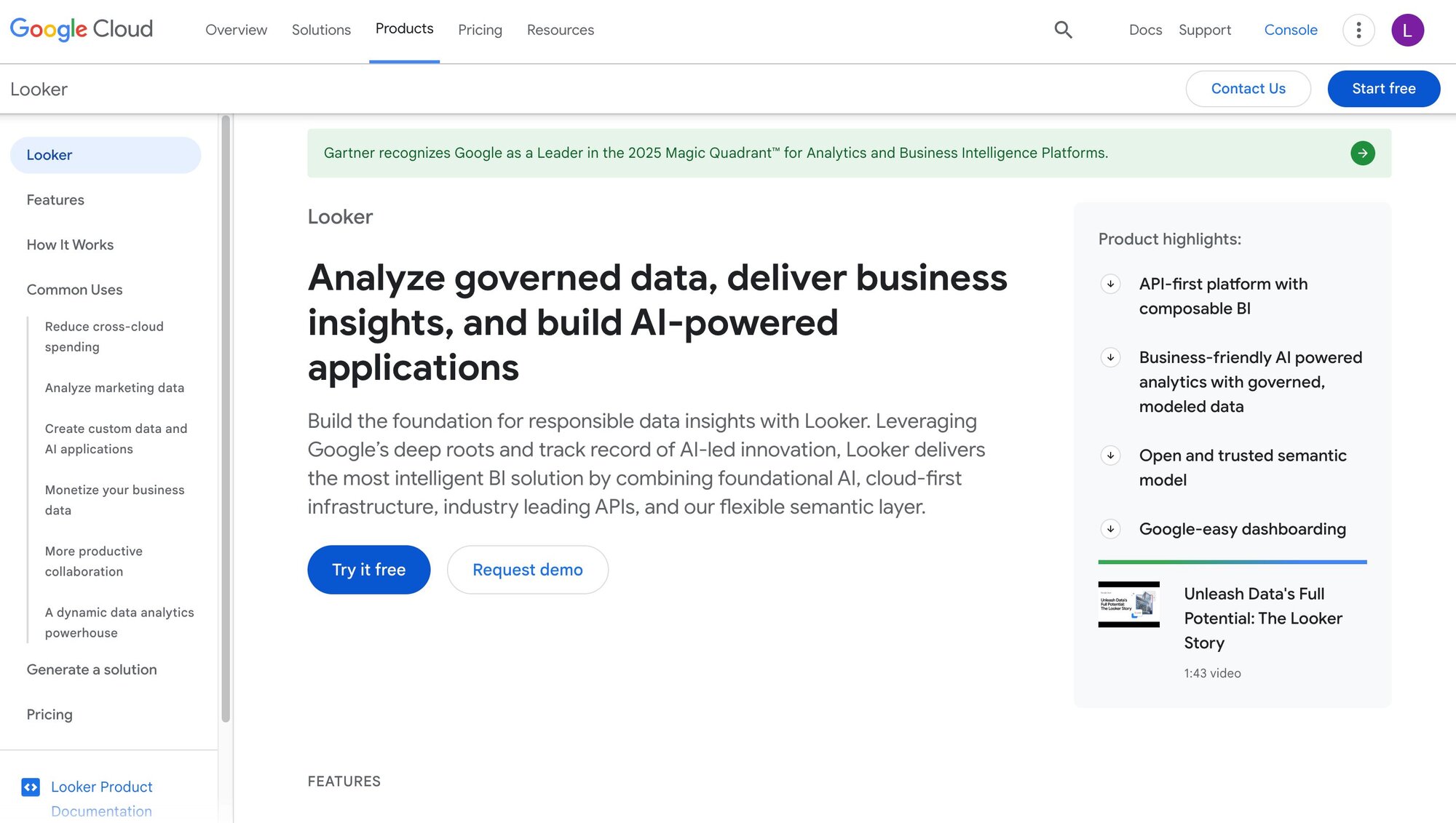
Looker is built for large organizations, and that became obvious during testing. Its modeling layer gave me precise control over metrics and definitions, which kept reporting consistent across teams.
Once I defined a revenue metric, every dashboard that used it pulled the same numbers, which cut down on confusion. Compared to Domo, this structure made governance easier and provided stronger oversight at scale.
When I connected warehouses like BigQuery and Snowflake, performance held up well. That consistency and scalability made Looker a strong fit for enterprises that prioritize governance and accuracy.
The tradeoff was setup time. I had to learn LookML to define models, and that created a learning curve. It wasn’t something I could just dive into without preparation. Once the models were in place, though, dashboards worked smoothly across large datasets.
Why it beats Domo
Consistent metrics: Define KPIs once and trust that every dashboard shows the same numbers.
Built for scale: Handle large datasets without losing performance when connected to warehouses like BigQuery.
Enterprise control: Use governance tools to manage access and keep reporting accurate across departments.
Pros
Reliable for large datasets and cross-team reporting.
Advanced modeling for consistent definitions.
Strong integrations with cloud warehouses.
Cons
Requires LookML knowledge, which adds complexity.
Pricing is enterprise-only, not ideal for small teams.
Pricing
Looker offers custom pricing. To learn more, contact sales.
Bottom line
Looker is a good choice for enterprises that need strict governance and scalable reporting. It demands more technical expertise up front, but the payoff is consistent reporting across large organizations.
5. ThoughtSpot: Best for search-driven analytics
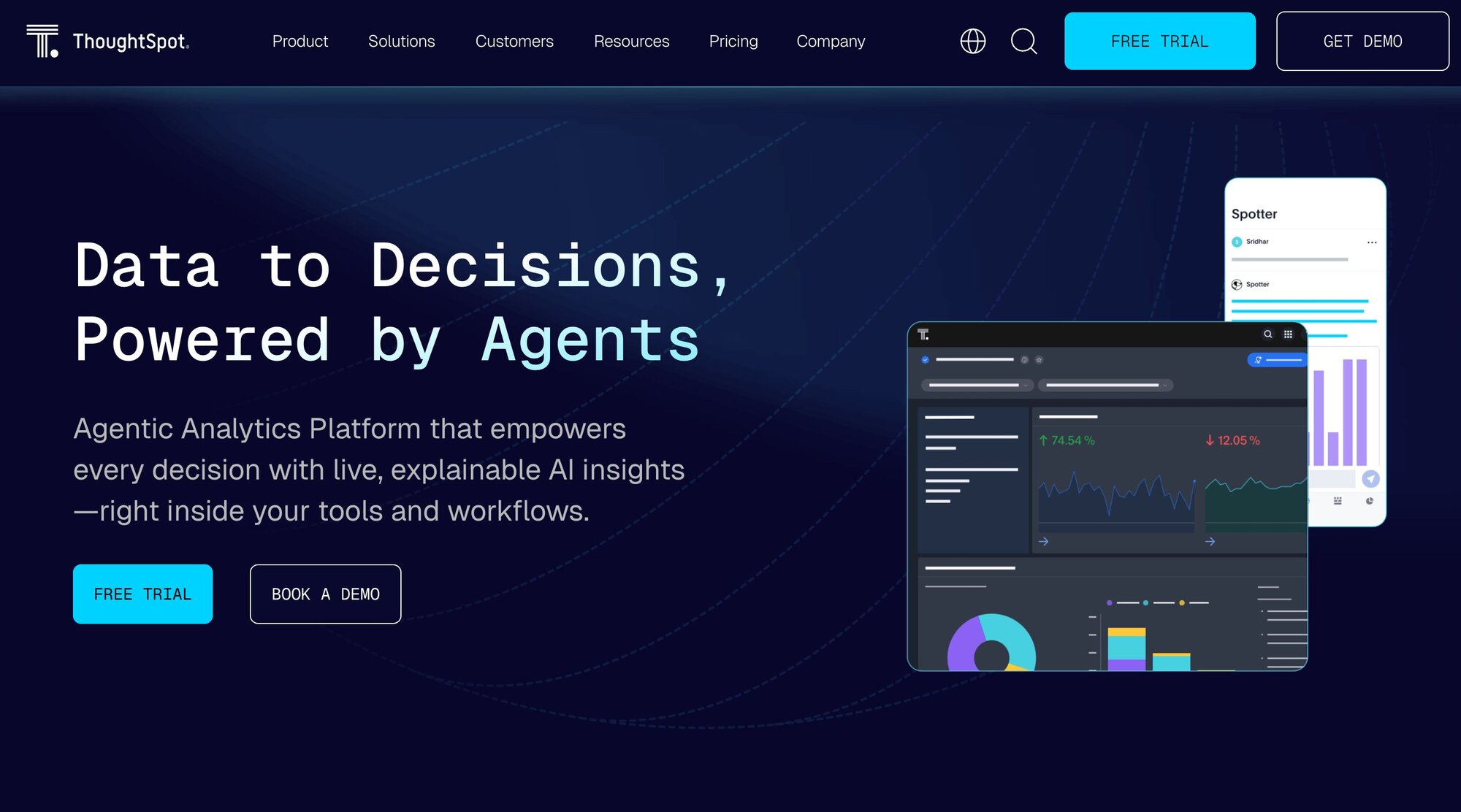
When I tested ThoughtSpot, the standout feature was its search-style interface. Instead of building dashboards, I typed questions into a search bar, such as “monthly revenue by region” or “top churn reasons last quarter,” and saw visual answers right away. Compared to Domo, it was faster for quick checks when I needed answers on the spot.
I also tried out the AI-driven insights, which flagged trends I might have missed. For example, it highlighted a spike in churn among monthly contracts that did not appear in my first view. That kind of guidance made it feel more than a simple reporting tool.
The tradeoff was depth. The search bar worked well for business users, but some of the more complex analyses still required technical help, and the pricing leaned higher than other tools.
Why it beats Domo
Ask and see: Type plain questions and get answers without building dashboards.
Guided insights: Spot trends and drivers that are easy to overlook.
Speed to answer: Check metrics on the fly without waiting for custom reports.
Pros
Simple interface that feels intuitive.
Fast answers for business users.
Strong focus on accessibility.
Cons
Pricing is high compared to smaller BI tools.
Complex analysis often needs technical support.
Pricing
ThoughtSpot offers a free trial. The Essentials plan starts at $25 per user per month (billed annually) for 5 to 50 users.
Bottom line
ThoughtSpot is a good fit if your team wants fast, search-driven insights without the setup overhead. It won’t replace technical tools for deep analysis, but it shortens the path from question to answer.
6. Sisense: Best for embedded analytics
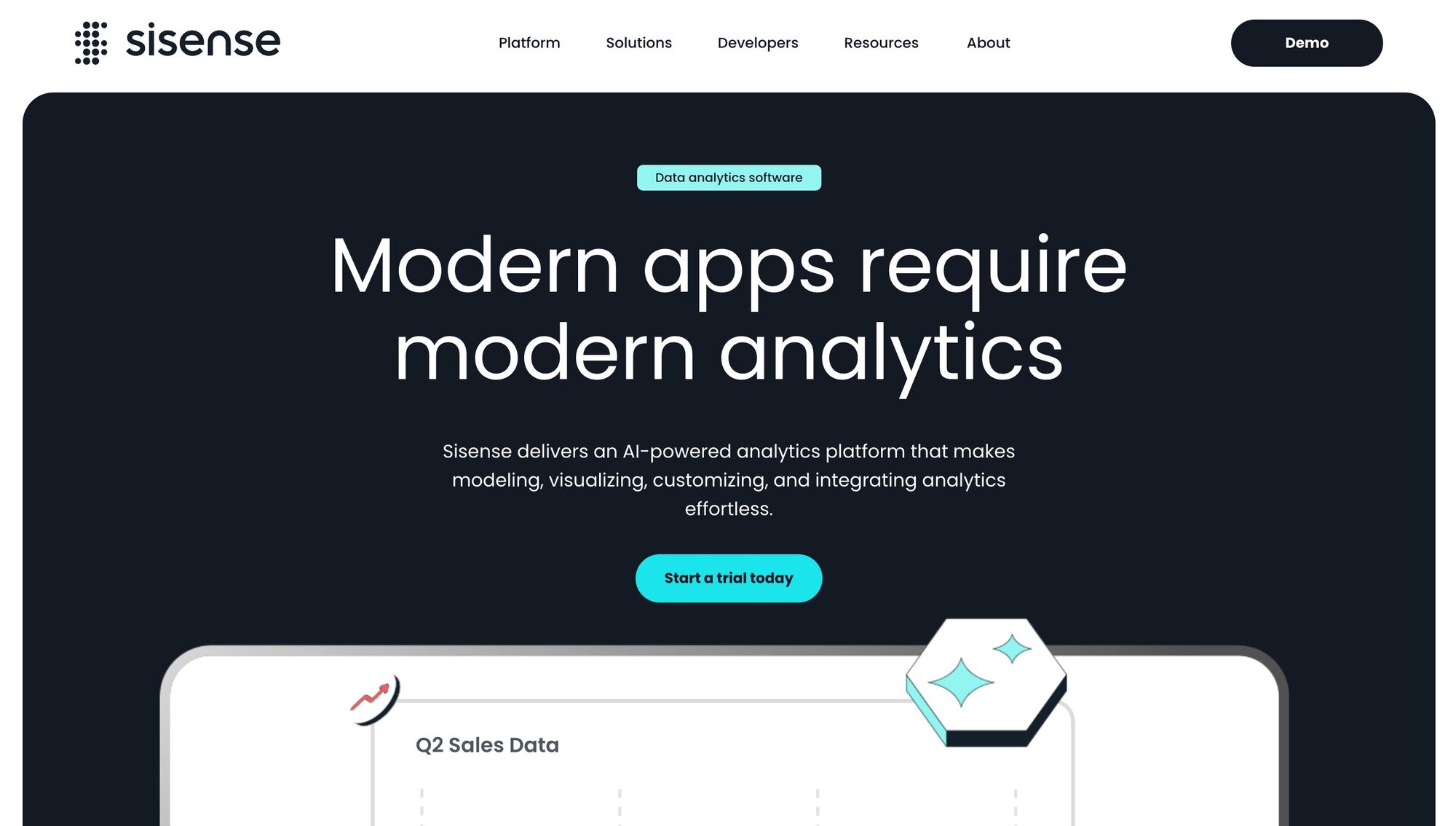
Sisense stood out for its ability to embed dashboards directly into other tools and workflows. I placed analytics inside apps my team already used, which made the data available without switching platforms. Compared to Domo, Sisense offered more flexibility for integration, especially with its developer options like the Compose SDK.
That flexibility came with a tradeoff. Sisense is developer-friendly, but that also means your company often needs IT or engineering support to get the most from it. In my experience, setting up embedded analytics required coding skills and time from developers.
Why it beats Domo
Embed anywhere: Place dashboards inside apps and workflows your team already uses.
Developer toolkit: Use the Compose SDK to build custom, context-aware analytics.
Real-time insights: Keep data visible without forcing users into a separate BI tool.
Pros
Embeds dashboards directly into business apps.
Strong customization through APIs.
Real-time analytics once set up.
Cons
Setup requires technical expertise.
Customization can take time to build.
Pricing
Sisense offers custom pricing. You can request a quote to learn more.
Bottom line
Sisense is a good choice if you need analytics inside your existing tools rather than in a standalone dashboard. It takes work to configure, but the result is smooth, real-time insights where your team already operates.
7. Mode: Best for SQL-heavy teams
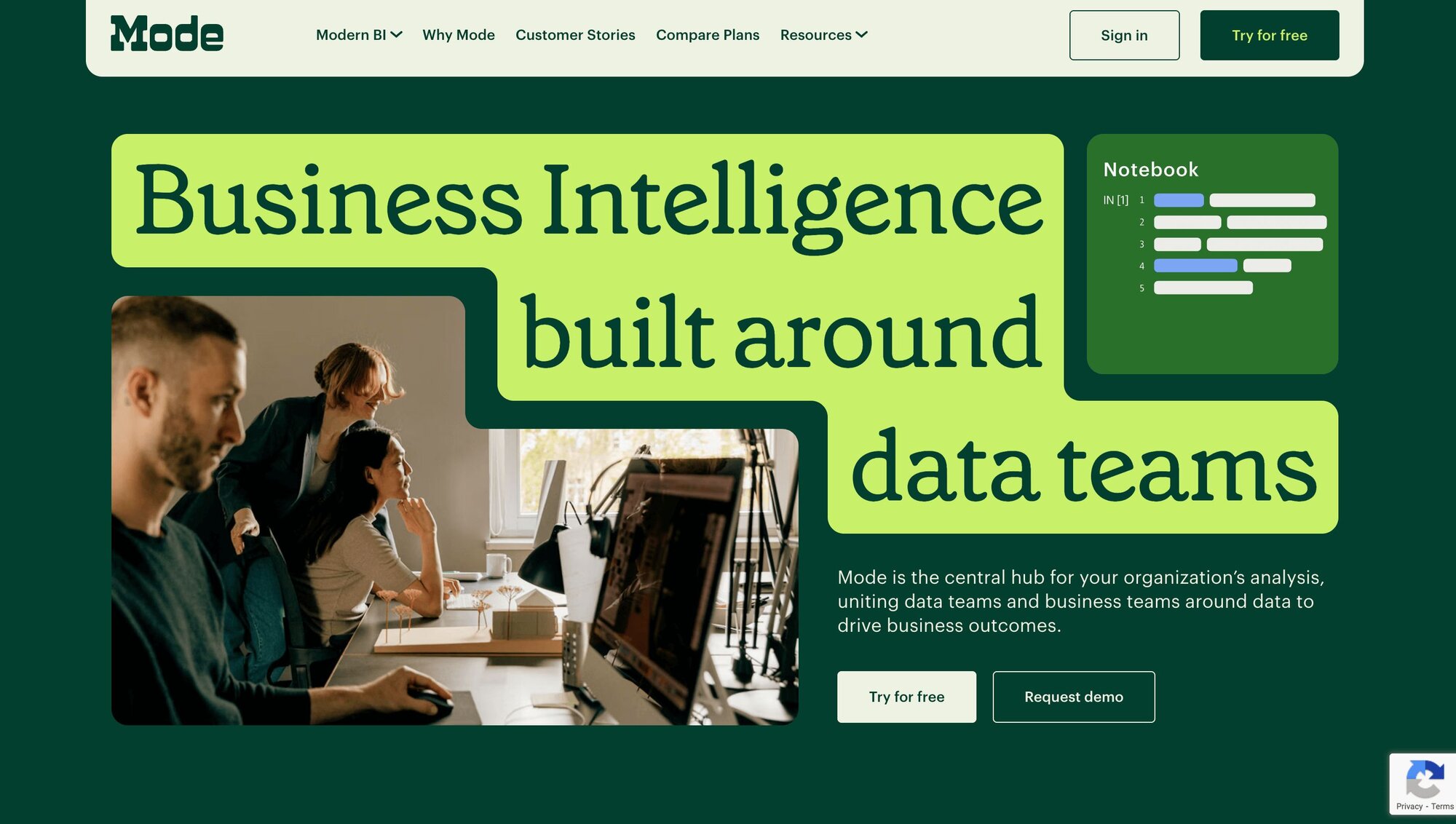
Mode is built for analysts who want flexibility, and I saw that as soon as I started using its notebook workflow. I could combine SQL with Python and R in the same project, which made it possible to run deeper analysis than what I could do in Domo.
For example, I wrote a SQL query to pull campaign performance data from Snowflake, then used Python to forecast churn. That mix of tools in one workspace saved me from bouncing between platforms.
Dashboards were also easy to share once the queries were in place. Mode let me take ad-hoc analysis and package it into an interactive report that teammates could explore without writing code.
Compared to Domo, this felt more open-ended and powerful, but it also came with a barrier. Non-technical teammates needed help from analysts to get started, since most of the value required writing queries or code.
Why it beats Domo
Flexible workflow: Combine SQL, Python, and R in one place for complex analysis.
Reusable notebooks: Turn ad-hoc work into reports that update automatically.
Collaboration: Share interactive reports that teammates can explore safely.
Pros
Strong for technical analysts.
Flexible mix of query languages.
Easy sharing within teams.
Cons
Not beginner-friendly.
Requires SQL or coding knowledge.
Pricing
Mode offers custom pricing. You can request a demo to learn more.
Bottom line
Mode works well for technical teams that want full control of analysis. It gives analysts more flexibility than Domo, but it isn’t built for business users who prefer drag-and-drop dashboards.
8. Qlik: Best for advanced analytics at scale
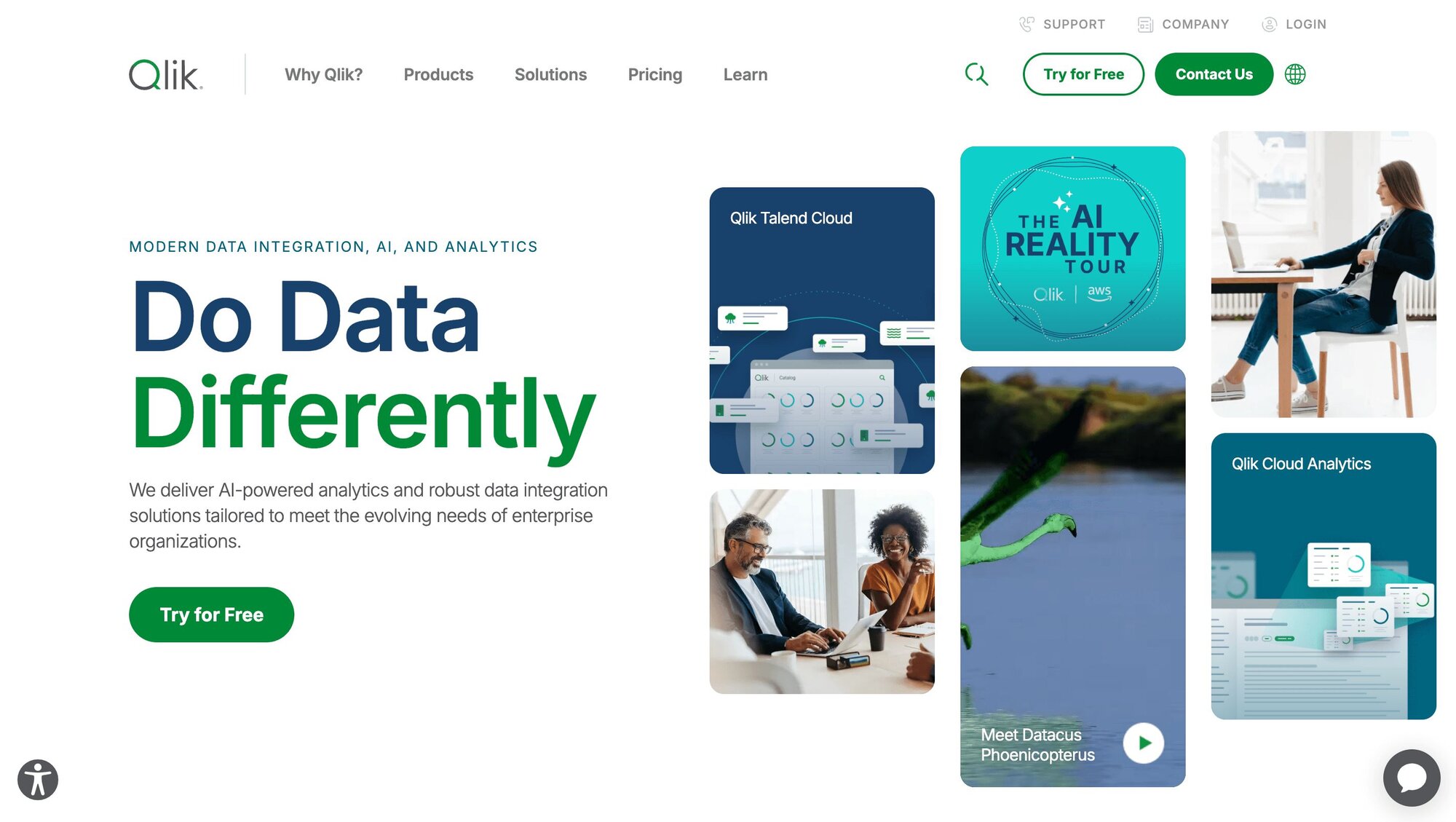
Qlik impressed me with its associative engine, which let me move across datasets and uncover relationships without writing complex joins.
For example, I could explore sales data by product, region, and time, all in one view. This let me spot patterns I might have missed in Domo. That flexibility stood out compared to more rigid query-based tools.
The tradeoff was setup time. Qlik took more effort than Julius before I could use it smoothly, since the interface was not as straightforward. However, it was faster to configure than Looker, which required learning LookML.
Once the environment was ready, Qlik handled large datasets without issue, and the AI features surfaced trends automatically. In my tests, that combination of scale and discovery made it clear why enterprises adopt Qlik.
Why it beats Domo
Associative engine: Explore across datasets without building predefined joins.
Scalable performance: Handle large data volumes while keeping dashboards responsive.
AI guidance: Get trend detection and context automatically from the platform.
Pros
Powerful engine for complex data analysis.
Good at spotting relationships across multiple sources.
Secure and scalable for enterprise needs.
Cons
Steeper learning curve than some competitors.
Can feel heavy for smaller teams.
Pricing
You can try Qlik for free. The Starter plan will run you $200 per month for 10 users.
Bottom line
Qlik suits enterprises that need advanced analytics and scalability. It takes more effort to learn, but the flexibility of the associative engine makes it stand out from Domo and other BI platforms.
9. Metabase: Best for open-source reporting
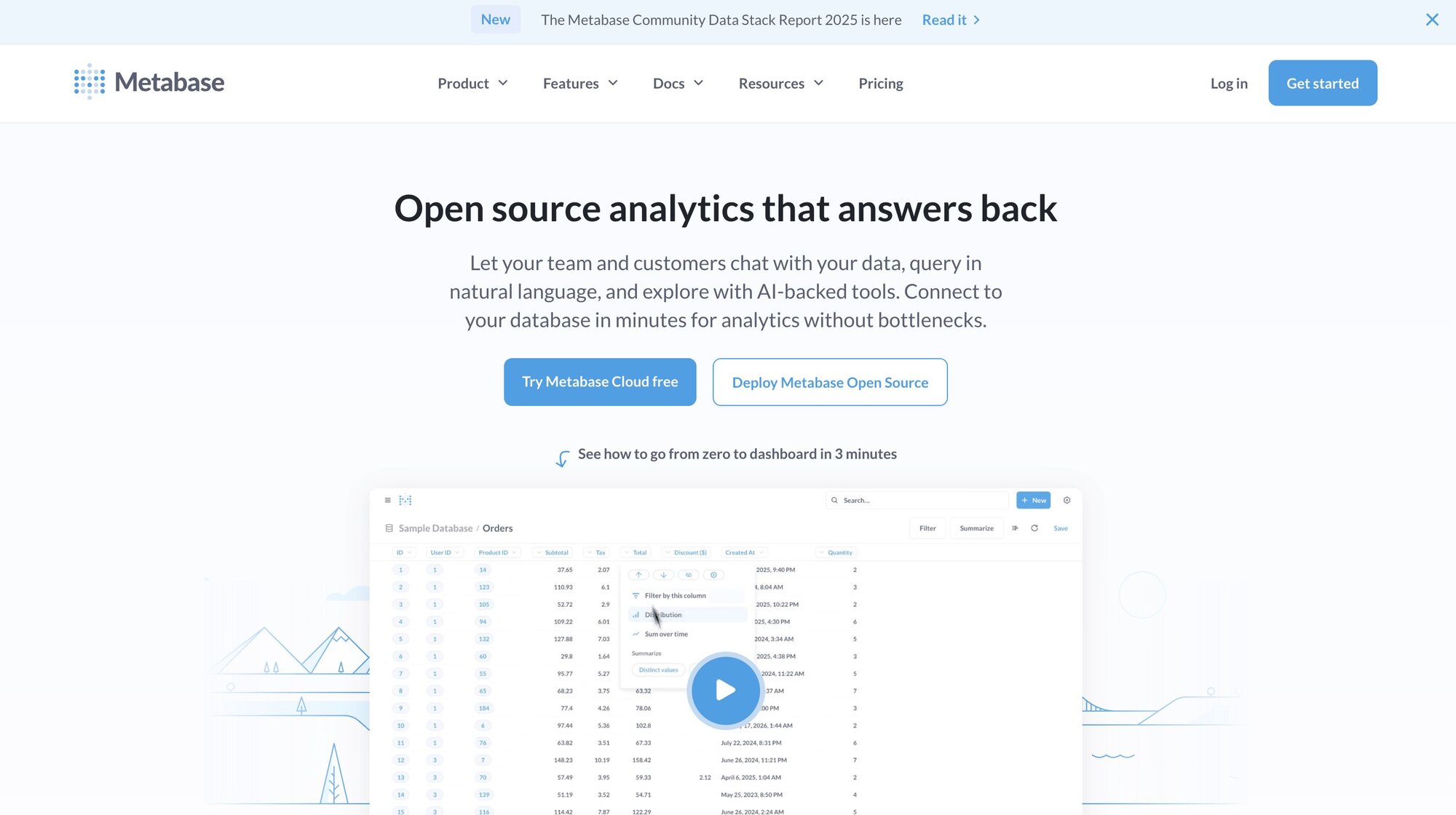
Metabase stood out to me as the most approachable open-source option. I installed it, connected a Postgres database, and within minutes, I was running queries and building simple dashboards.
The interface was clean and lightweight, which made it less intimidating than Domo. I could ask questions through its GUI, filter data, and share charts quickly with my team. For smaller companies, that combination of free access and simplicity is hard to beat.
The tradeoff showed up when I tried to scale. Domo provides built-in governance and more structured modeling, while Metabase leaves much of that to the user.
In my tests, I found it easier to get started in Metabase than in Domo, but harder to maintain consistency as projects grew.
For example, I built a sales performance dashboard easily, but standardizing metrics across multiple teams took more work. Paid plans add features like permissions and priority support, which help, but it still leans small to mid-sized compared to enterprise-ready platforms.
Why it beats Domo
Low barrier to entry: Start for free and get dashboards up in minutes.
Ease of setup: Connect databases like Postgres or MySQL with minimal configuration.
Budget-friendly: Open-source core means no large upfront contract.
Pros
Free open-source version available.
Clean, user-friendly interface.
Quick setup and fast results for small teams.
Cons
Limited governance and modeling compared to enterprise tools.
Paid features needed for permissions and advanced security.
Pricing
Metabase offers a free open-source version. Paid cloud plans start around $85 per month for 5 users.
Bottom line
Metabase is a good alternative to Domo if you want affordable dashboards without enterprise complexity. It works best for startups or smaller teams that value quick setup and clear reporting, while larger organizations may outgrow its governance and modeling limits.
10. Zoho Analytics: Best for all-in-one business users
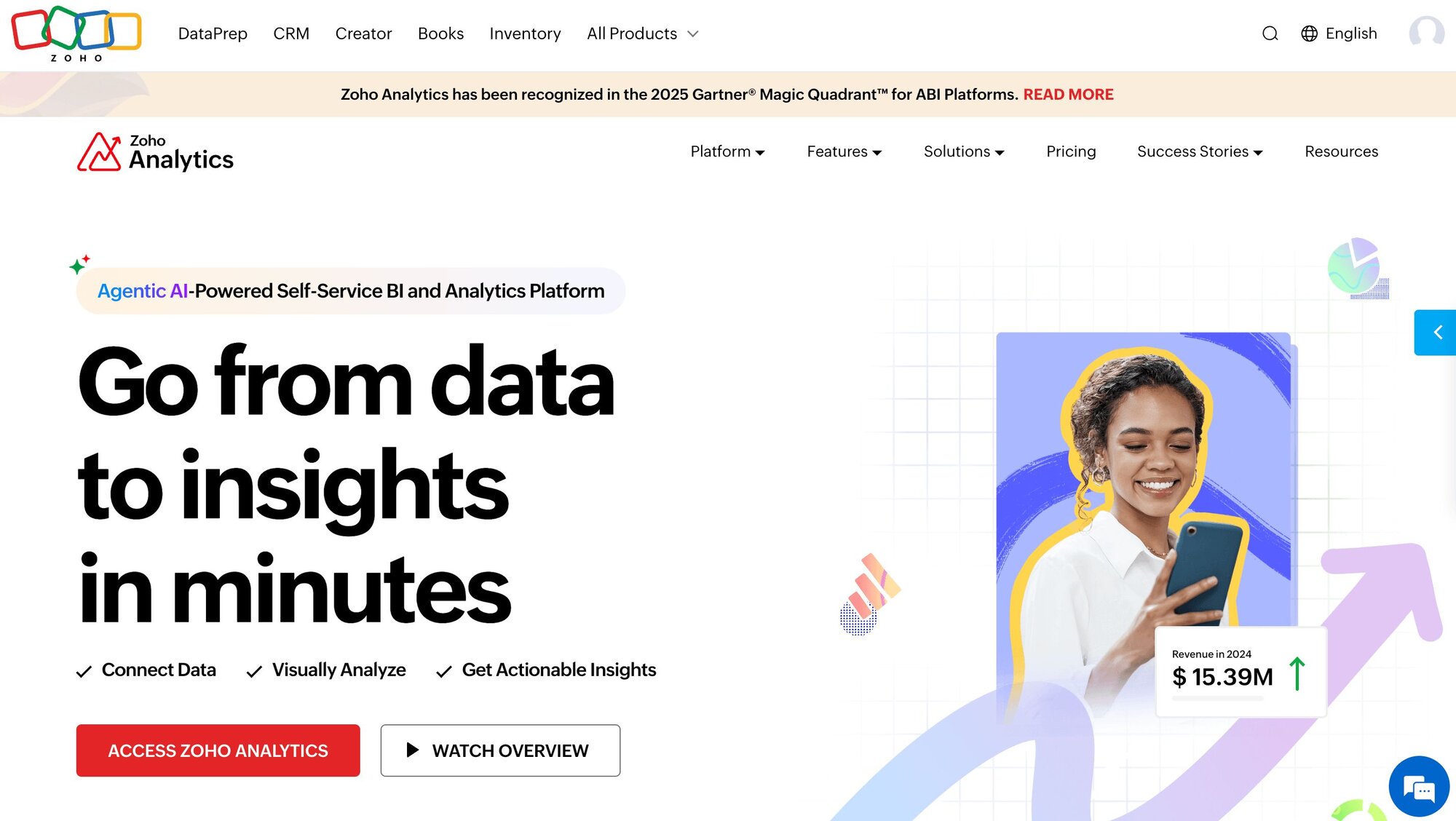
Zoho Analytics fit right into the rest of the Zoho ecosystem when I tested it, which made it attractive for small to mid-sized businesses already using Zoho CRM, Books, or Projects.
I connected a few sample datasets and built a sales dashboard in under an hour, complete with regional breakdowns and trend lines. The interface leaned more approachable than Domo, and the prebuilt connectors to Zoho apps cut down on setup time.
The real advantage here was convenience. With Domo, I often had to spend time setting up integrations or modeling data before dashboards worked. In Zoho Analytics, reports were almost plug-and-play when I stayed inside the Zoho stack.
The downside was depth. While the tool handled sales and marketing reports easily, it didn’t offer the same advanced modeling or large-scale governance that Domo and Looker provide. For a growing SMB, though, the simplicity and lower cost were more practical.
Why it beats Domo
Quick start: Build dashboards rapidly with drag-and-drop tools.
Native integrations: Connects smoothly to Zoho apps without extra setup.
Affordable pricing: Subscription model works for SMB budgets.
Pros
Easy to learn for non-technical users.
Strong prebuilt integrations within the Zoho ecosystem.
Cloud-based with team collaboration options.
Cons
Less flexible outside the Zoho ecosystem.
Limited governance compared to enterprise tools.
Pricing
Zoho Analytics starts at $60 per month for 5 users with cloud deployment and $30/user/month for a minimum of 5 users for on-premise. There are higher tiers with more data and advanced features.
Bottom line
Zoho Analytics is a strong Domo alternative for small to mid-sized businesses, especially if you already use other Zoho apps. It doesn’t match enterprise tools on scale or governance, but for straightforward reporting and affordability, it gets the job done quickly.
11. Strategy (formerly MicroStrategy): Best for enterprise intelligence
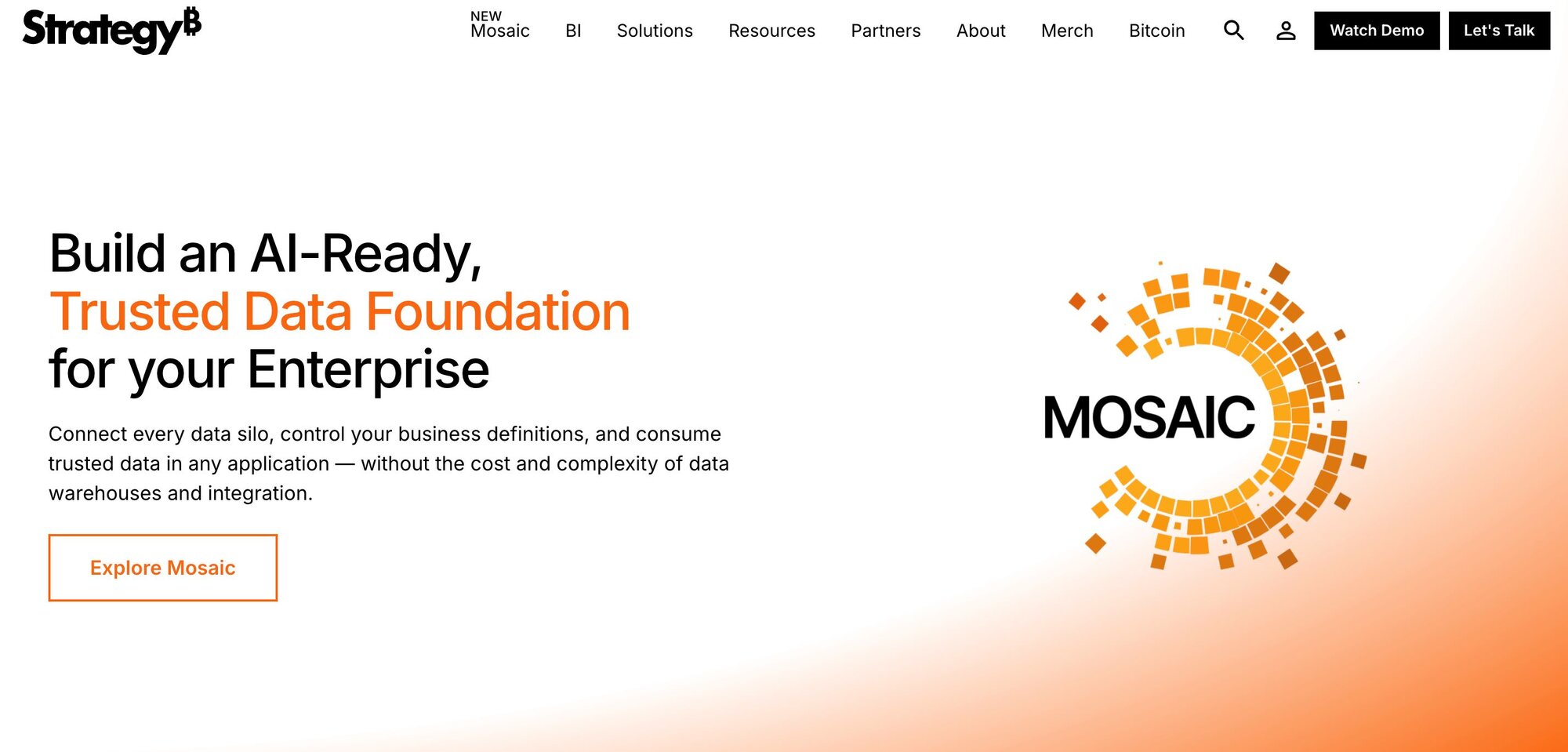
Strategy came across as the most enterprise-focused platform I tested. It delivered strong governance, mobile BI, and advanced security features that felt designed for organizations with thousands of users.
I built a financial reporting dashboard using data from Snowflake, and once the models were in place, the dashboards scaled reliably across large datasets. Compared to Domo, Strategy offered more control over permissions and a deeper suite of enterprise-ready features.
The tradeoff was accessibility. It took more time to set up Strategy than tools like Julius or Power BI, and I needed IT involvement to manage integrations and security settings. But after everything was set up, the payoff was consistency.
Once configured, every team used the same metrics without variation, which reduced the reporting conflicts I often see in smaller tools. For companies that need audit trails, strict governance, and mobile access for executives, Strategy stood out.
Why it beats Domo
Enterprise governance: Control user permissions and maintain consistent metrics across departments.
Scalable performance: Manage enterprise-scale data without performance issues.
Mobile BI support: Give executives and field teams access to dashboards on the go.
Pros
Strong governance and security features.
Scales well for very large organizations.
Reliable mobile and offline reporting options.
Cons
Requires IT support for setup and management.
Complexity makes it less approachable for small teams.
Pricing
Strategy offers a $13 per user per month price for teams of 50 to 300 employees. Enterprise plans are available at custom pricing.
Bottom line
Strategy is a strong choice for large enterprises that need strict governance and mobile BI capabilities. It requires more setup and IT involvement than lighter alternatives like Julius or Power BI, but delivers consistent reporting across large datasets with enterprise-grade security that outpaces Domo's offerings.How I tested and compared these financial analysis software tools
To keep everything consistent, I set up trial accounts (or scheduled demos), connected sample data, and ran the same core jobs in each platform. I focused on finance and marketing examples because those are common use cases for Domo. This gave me a consistent way to compare how each tool performed.
Here’s what I looked at:
Setup speed: I timed how long it took to load data, connect a warehouse, and produce a first chart.
Ease of use: I checked whether a manager without SQL could ask questions and get useful answers.
Visualization quality: I compared the dashboards side by side to see which ones looked clear enough for executives.
Integration coverage: I tested connectors for Snowflake, Postgres, and Google Ads since those are frequent needs.
Pricing clarity: I looked for upfront pricing and tracked which tools required custom quotes.
This approach helped me sort out which alternatives to Domo are practical for small teams and which ones make more sense at enterprise scale.
How to choose your Domo alternative
Cost, ease of use, and scale all play a role when you’re deciding which of the top platforms to pick. Choose:
Julius → if you want fast answers in plain language without learning SQL.
Tableau → if you need polished dashboards and advanced visualizations.
Power BI → if you’re on a tighter budget and already work in Excel.
Looker → if your company requires strict governance and scalable reporting.
ThoughtSpot → if your team prefers typing questions into a search bar for instant insights.
Sisense → if embedding analytics into apps and workflows is a priority.
Mode → if your analysts work best with SQL, Python, or R.
Qlik → if you manage complex data at scale and need an engine that uncovers hidden relationships.
Metabase → if you want affordable dashboards without enterprise complexity and quick setup.
Zoho Analytics → if you already use Zoho apps and need straightforward reporting for SMBs.
Strategy → if you're a large enterprise that needs strict governance and mobile BI capabilities.
These points can help you match the right platform to your needs without overpaying for features you don’t use.
My verdict
After testing these tools, I realized that each one solves a different problem. What made the difference for me was matching the tool to the way my team actually works.
Julius stood out when I needed quick answers in plain language, like cash flow by month, NRR across customer cohorts, or ad spend by channel. I could type the question, get a chart in seconds, and even schedule the report to hit Slack or email automatically.
Tableau gave me the most flexibility with visuals, while Power BI made analytics more affordable for smaller teams. Looker handled governance and scale better than the rest, and ThoughtSpot impressed me with its search-driven approach.
Ready to switch from Domo? Start here
We designed Julius to give you fast answers to everyday business questions, such as weekly revenue, customer churn, or board-ready summaries, without requiring SQL or a long setup.
If you’re exploring Domo alternatives because of cost, time, or ease of use, Julius can handle your daily reporting, quick forecasts, and performance tracking so your team keeps moving.
Here’s how Julius can help:
Ask questions in plain language: Type “Show cash flow by month” or “NRR by cohort,” get a chart in seconds.
Database connectors: Pull data from Postgres, Snowflake, or BigQuery without SQL.
Scheduled reports: Send weekly or monthly updates to email or Slack on autopilot.
Ad-hoc checks: Run quick reads for board decks, investor notes, or internal reviews.
Notebooks: Save an analysis, like an NRR breakdown or cash flow report, and rerun it with fresh data whenever you need it.
Ready to see how Julius compares to your current stack? Try Julius for free today.
